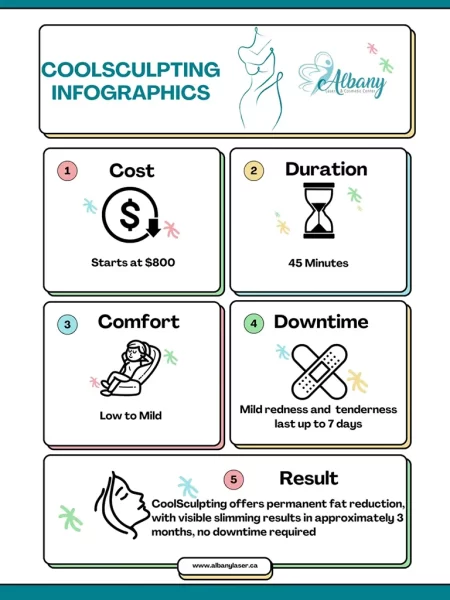Cryolipolysis Edmonton: Non-Surgical Fat Freezing at Albany Cosmetic and Laser Centre
Cryolipolysis, also known as “coolsculpting,” is a non-invasive process for reducing fat in the abdomen and other parts of the body. It was developed by scientists at Massachusetts General Hospital who noticed that some children developed dimples due to the consumption of popsicles.
- The procedure is based on the idea that fat cells are more sensitive to cold than other cells and, thus, can be selectively destroyed when exposed to certain temperatures for a certain amount of time.
- This non-surgical procedure involves cooling unwanted fat cells in a specific area of the body. A vacuum applicator device is first attached to the desired area, and then a precise amount of coolant is applied directly to the skin at a controlled temperature below freezing point (about -8°C).
- The cooling process causes structural changes in the fat cells, which then gradually die off over time. During the treatment, patients will experience sensations like tingling or tugging as well as some mild discomfort. However, most patients find that it’s very tolerable. The treatment typically takes about an hour or two, depending on what areas are being treated and how much fat needs to be removed.
Do you have a question? Chat with Dr. Smart, our friendly AI assistant available 24/7!
Results and advantages
The results from Cryolipolysis can be seen within two weeks of treatment but may take up to three months before they can be observed completely after all the dead fat cells have been eliminated through natural processes.
- In most cases, patients need only one session per area; however, it varies depending on each individual’s body type and the amount of fat needing removal.
- The advantages of Cryolipolysis compared with other methods are numerous. Firstly, because it’s non-invasive, there is no risk associated with surgery or any long recovery times associated with it; also, there is no scarring since no incisions are made during this procedure, unlike with liposuction surgeries or laser treatments used for body contouring.
- Furthermore, Cryolipolysis can treat multiple areas simultaneously, making it a highly efficient method for body sculpting; likewise, this technique enables us to target particular areas with accuracy and precision, which may not be possible with other procedures such as liposuction, which tends to be indiscriminate in terms of where it removes tissue from within our bodies—this means less risk associated with undesired outcomes such as lumps or unevenness in skin tone/texture which may result from traditional methods such as liposuction and other surgical techniques employed for removing excess fat deposits from our bodies.

Cryolipolysis Safety
In addition to its efficiency and safety profile, Cryolipolysis has also proven itself cost-effective compared with other forms of cosmetic therapies; since only one session at most is needed per treatment area, this means that overall costs tend to be lower than those associated with traditional methods such as liposuction which often require multiple sessions supplemented by additional treatments including steroid injections (to reduce swelling) or massages (to soften scarring)—these additional treatments add up quickly resulting in higher total expense compared with Cryolipolysis alone!
Furthermore, these benefits extend beyond just monetary savings—since no anesthesia is required during this procedure, patients don’t face any potential dangers/risks associated with general anesthesia either before or after their treatment session ends, making them safer than more invasive procedures like plastic surgery which require more intensive pre/post-operative protocols that carry greater risks overall! Finally we should note here too that post-treatment care and follow-up appointments are often unnecessary following cryo-based therapies meaning fewer trips back into doctor’s offices/clinics after your initial visit—all these factors combined make cryo-based approaches like Cryolipolysis much more attractive than their surgical counterparts when weighing cost vs benefit ratios!
